October 24
Set out at the ungodly hour of 5:30, having already breakfasted. We have about a 3-hour drive to (what had better be) the terrific Kond market, called Chatikona, which operates only on Wednesday. There are approximately 1.8 million Konds in India.
Before giving you a rather lengthy discourse on the Konds, I’ll tell you briefly about my day, then tack on the Kond description at the end. I think it’s quite interesting, but it may not be everyone’s cup of tea. So, you decide.
Arriving at the Kond market, we see Konds walking down from the mountain.


Because the government has built a road partway up the mountain, some of the Konds come down the last part of their trek in vehicles, typically stuffed to the gills with people.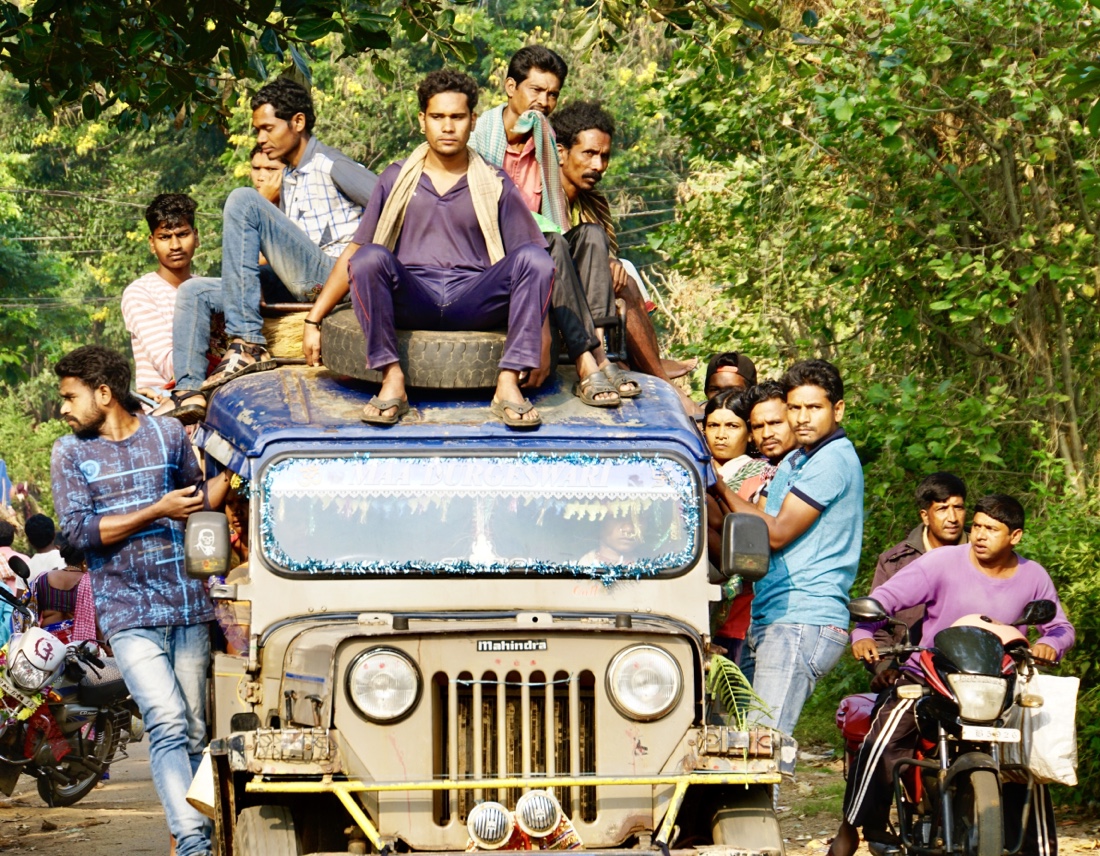
The market was indeed interesting, largely because of the opportunity to observe the dress and jewelry, which distinguish the Konds from other tribes and from different types of Konds. The market itself stretches across a railroad track,
down a hill, along a highway and then into a large rectangular area. The weekly tribal market provides the opportunity for tribes to sell their products through a barter system which still prevails, get their weekly provisions, provides an opportunity for community elders to interact with others in their village, for girls to display their best of costumes and jewelry, and for the young men to display their courage to attract women.



 Before we got to the market, Prasant told me that the members of the tribe were aggressive and that I should not show people photographs that I take and be careful. He said sometimes they threw things at people trying to take pictures. I did not experience any aggressive behavior, but the Konds were noticeably less friendly than other people we’ve encountered and almost never smiled. Happily, though, they did not try to sacrifice me.
Before we got to the market, Prasant told me that the members of the tribe were aggressive and that I should not show people photographs that I take and be careful. He said sometimes they threw things at people trying to take pictures. I did not experience any aggressive behavior, but the Konds were noticeably less friendly than other people we’ve encountered and almost never smiled. Happily, though, they did not try to sacrifice me.
This was the only market we’ve been in in which people tried actively to sell things to the very few tourists who were around. I did buy a few trinkets, but I think Carol would be proud of how I bargained (though I’m sure she would’ve gotten each item for less than I did).
After walking through the market, we relax and have a coffee there, then proceed to the first of three villages we visit, Gaudaguda, in which the Desia khandh live.
After the first village, we stop at a hotel to have an excellent Indian lunch, before continuing on to the other two villages. I am coughing badly, suffering from the smoke I inhaled at the pottery village yesterday.
We go to two more villages, Punjapai, where the Kuvi kandha live and Minapai, which is also a Kuvi kandha village in which most all of the villagers are engaged in making bamboo baskets.
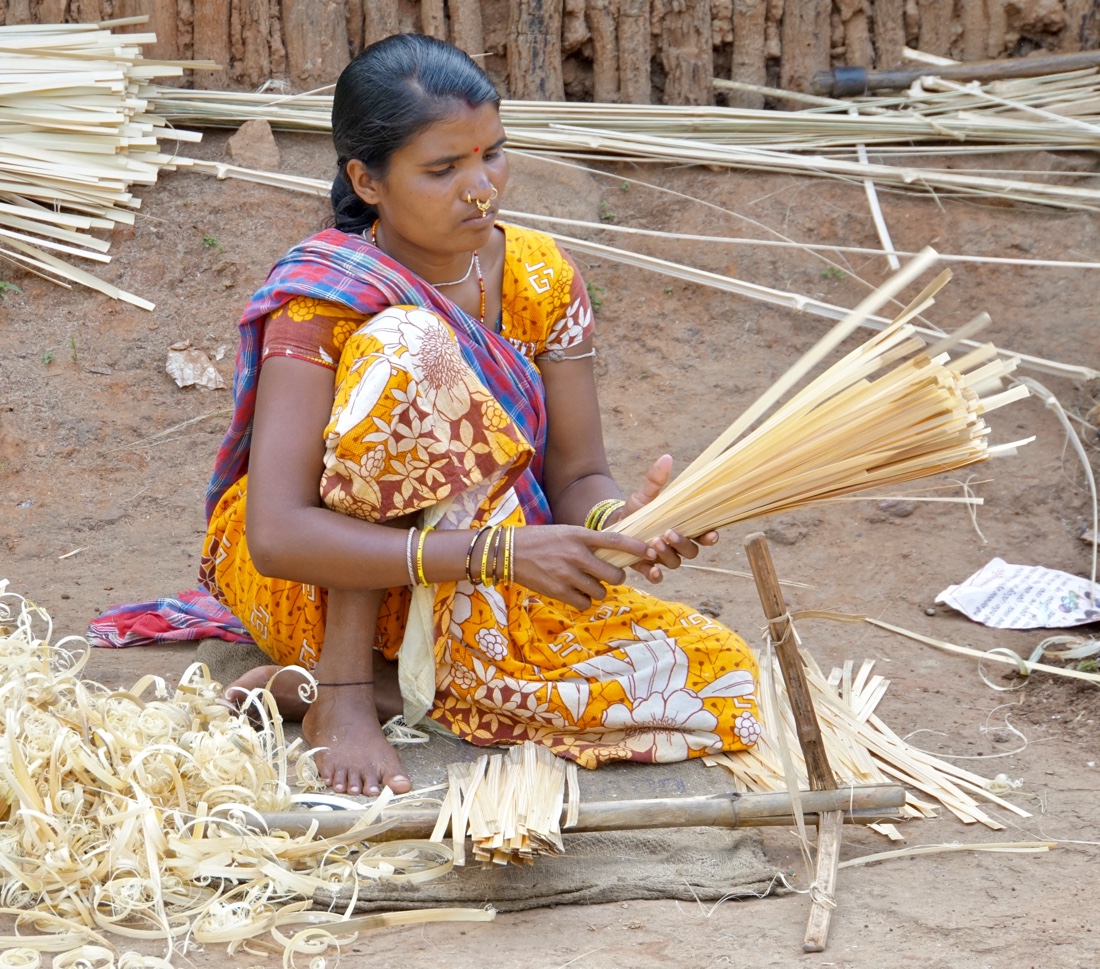 Prasant is something of a pied piper, as he buys packages of cookies and hands out cookies to the children. After visiting the third village, Prasant asked whether I’d like to go to another one. I demur, though, saying that I am marketed out. It’s been a tiring day. We started out very early and I didn’t sleep very well because of the cough. Though we did not do a lot of walking, we were on our feet for significant periods of time and when we were in the sun, it got pretty hot. And, oh yes, I’m old.
Prasant is something of a pied piper, as he buys packages of cookies and hands out cookies to the children. After visiting the third village, Prasant asked whether I’d like to go to another one. I demur, though, saying that I am marketed out. It’s been a tiring day. We started out very early and I didn’t sleep very well because of the cough. Though we did not do a lot of walking, we were on our feet for significant periods of time and when we were in the sun, it got pretty hot. And, oh yes, I’m old.
Here are some photos that I have not sorted by village.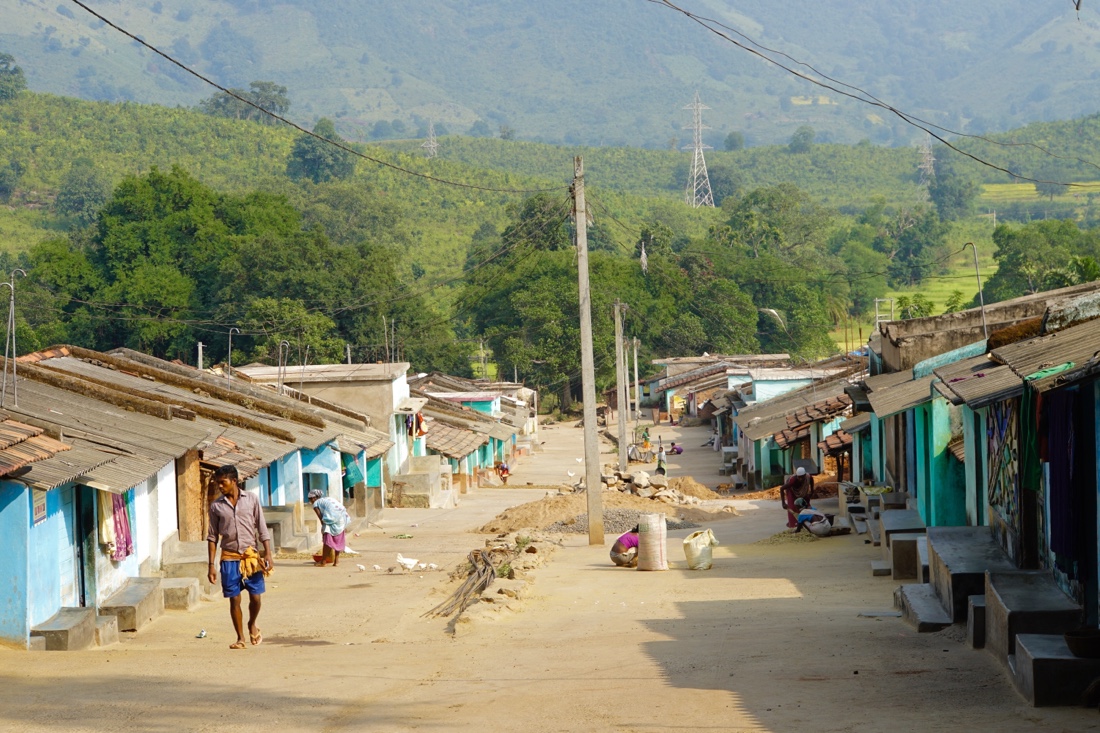





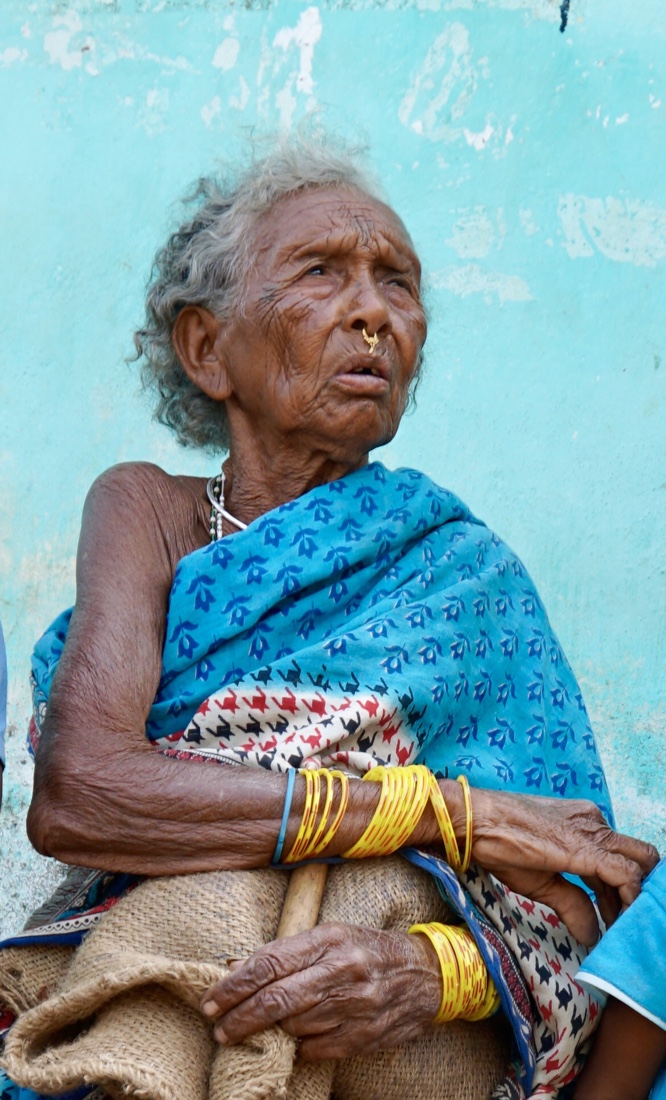


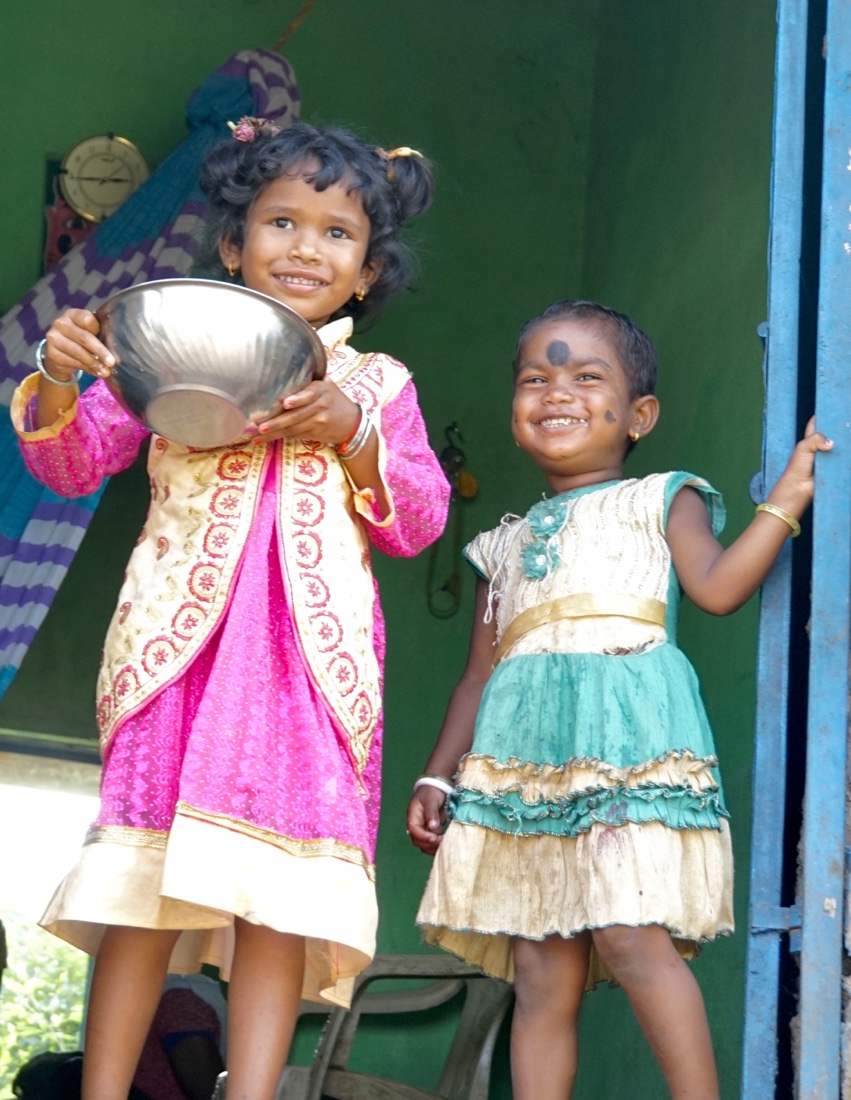




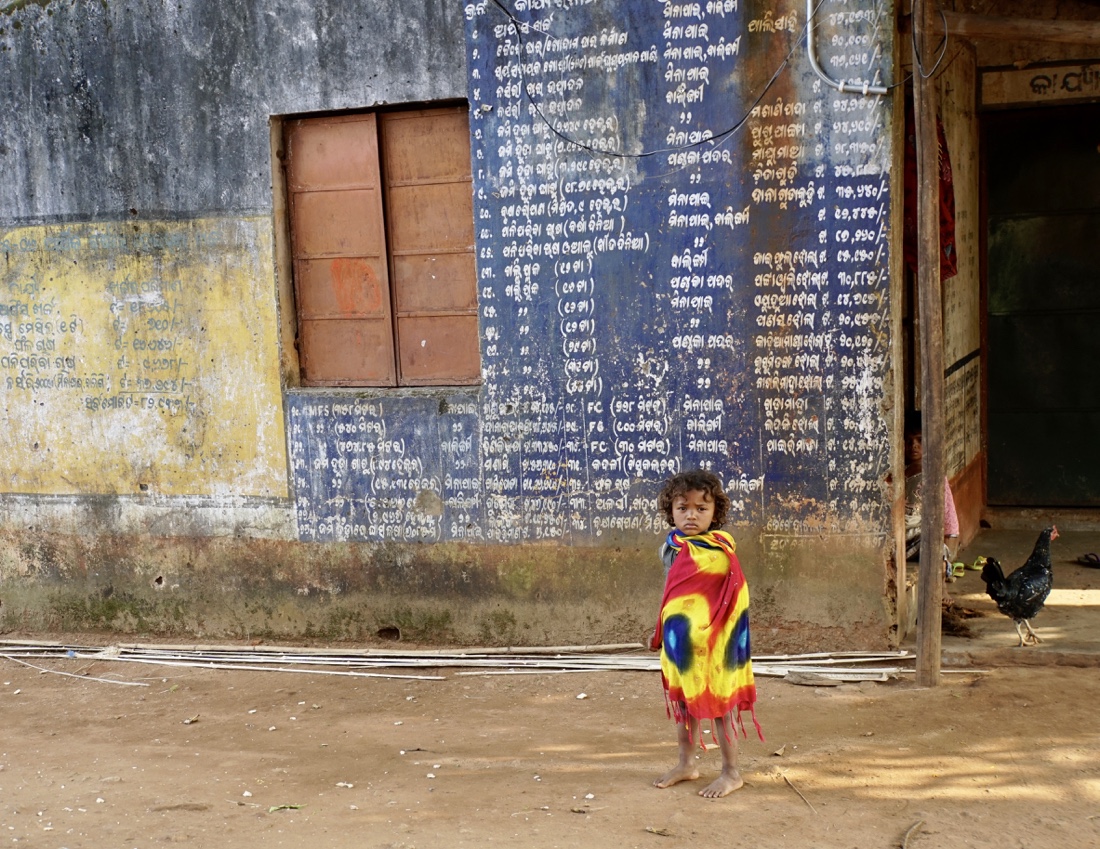
We return to the hotel, eleven hours after setting off, and I have a couple hours to relax, shower and blog, before another good dinner. Two French have stayed behind, Yves, about to be 65, and his daughter, Melodie. Yves has masked the fact that his English is excellentt and he talks about an amount of travel that makes me seem like a homebody. The two Spanish people, whose English is a bit better than my Spanish, are also at the table. The guy, whose name I did not get, travels around the world studying shamans and their methods of healing. He’d be a helluva interesting guy to have at a dinner party, if his English were better.
Over night and during the day today, I succeed in changing my plane reservations, so that I fly from one unpronounceable city directly to Delhi, rather than first flying from that unpronounceable city to Kolkata. The old plan made sense when I was going to take a group trip that ends in Kolkata, but it does not make sense now. With the help of travel agents in the US and Delhi, I figured out how to change it (at some cost, but, what the hell, it’s only money and I’m probably going to die of this cough, anyway, unless the Vick’s Vaporub that Prasant bought me manages to save me.) I’m going to try to make it through the trip, though, so that you can see how it ends.
Tomorrow is another long day, as we set out at 6AM.
Here may be more than you ever wanted to know about the Konds, but give it a try.
THE KONDS
The name Kandha translates as “mountaineer” and probably comes from the Dravidian word konda meaning hill.The Konds themselves believe they originated in Orissa and have always lived in their present location. The Kond tribe has a number of sub-tribes, including the Dongria, Kovi, Kuttia, Languli, Penga, and Jharnia.
They worship the mother goddess called penu, which means goddess of Earrth. Gods and Goddesses are believed to be very sensitive to neglect, disobedience, and violation of taboos. They react by ruining a crop, sending a tiger to attack cattle, or making the offender sick. They have to be propitiated by blood-offerings, and so sacrifice is an integral part of Kond religion. Priests officiate at sacrificial rituals, which in former times included human victims as well as animal ones. The Meriah or human sacrifice was stamped out by the British in the late 19th century.
Worship of the spirits of dead ancestors is also an important aspect of traditional Kond religion.
All important festivals are accompanied by animal sacrifice. Following the suppression of the Meriah human sacrifice, the Konds accepted buffaloes as substitute victims. Thus the Meriah festival, which is held between March and May, is still celebrated with buffaloes sacrificed as an offering to the Earth Goddess.
.
Kond houses or huts are rectangular in shape, with the walls made of timber and plastered over with mud. The floor is of hardened dirt, and the low roof is built of bamboo thatched with grass. The huts are small, consisting mostly of one room, which is shared with the livestock. Furnishings are sparse, with the occupants sleeping on wooden cots or reed mats. Only the father, mother, and younger children sleep in the house. Around the age of eight or so, Kond girls and boys leave home to live in segregated village dormitories under the supervision of an elderly female. As in many tribal societies, the dormitory system lends itself to a somewhat casual attitude to premarital sex among Kond youth.
Konds are divided into clans, each of which claim descent from a common ancestor. Typical names of subclans are Hikoka (horse), Kelka (kingfisher), and Kadam (a tree). The Konds are a warlike people, and in the past clans were continually fighting one another. Conflicts were usually over land or women.
The Kond family is typically patrilineal and nuclear in structure. Women are highly respected and are entitled to almost the same privileges as are men. Women manage the household, plant and weed the rice paddies, and raise the young, but they are also consulted before decisions are made in domestic affairs. Women attend the village council, where they can voice their opinion on matters relating to community affairs.
The traditional dress of Kond men is a long cloth, a few inches wide, that is wrapped around the waist and drawn between the legs.
Rice is the staple food of the Konds. It is eaten with lentils and with wild leafy vegetables gathered in the jungle. The diet is rather bland compared to the spicy curries eaten by other peoples in India. Konds are nonvegetarian, eating eggs, chicken, buffalo, goat, pork, and even beef. The Konds do not use milk. Wild game is hunted in the forest to supplement the diet. Konds enjoy alcohol, drinking rice-beer, toddy, or liquor made from mahua flowers.
Access to educational facilities has always been a problem for Konds living in the remote interior of the Eastern Ghats. Although some 30% of Kond children attend government schools today, many drop out because of economic hardship and the need to help support their families. The drop-out rate by Grade 5 is close to 80%. Literacy among Konds is low, with the rates (2001) among the Dongria Konds, who live in the Niyamgiri ranges of Orissa, being 29% for men and 14% for women, respectively.
Music, song, and dance play an important role in traditional Kond culture. Instruments include trumpets, drums, and the shepherd’s pipe. The deka, a two-stringed violin made with a bamboo stick and gourd, provides the musical accompaniment as the poet sings, or rather chants, the verses. There are songs for every occasion—love songs, songs to be sung on the eve of the Meriah sacrifice, at marriages, at the time of plowing, and at the time of death. Of greater importance is the Kond dance. Every village has a place set aside for dancing. In a dance of the Kuttia Konds, boys and girls stand in a row facing each other. They link arms and shuffle back and forth in time to the music, getting more agitated and excited as the tempo of the dance quickens. Konds arm themselves with weapons for the war dance, in which they mimic a battle scene. In a hunting dance, a man wearing the horns and skin of a wild animal is chased and captured by a party of “hunters.” Dancing accompanies festivals, marriages, and other important events and may continue day and night until the dancers are exhausted.
Although originally hunters and gatherers, most Konds are now engaged in agriculture. Rice, maize (corn), and pulses are important food crops, while turmeric, mustard seed, and legumes are grown as cash crops. Many Konds work as agricultural laborers, while some still hunt or gather forest products such as teak.
Of particular interest are the relationships of the Konds with the Panas and Doms. These are peoples who live in the Kond hill country, sometimes even in Kond villages, who act as traders, money-lenders, and intermediaries between the Konds and the Hindus. They also carry out certain ritual functions, which the Konds are forbidden to perform themselves.
.
Kond folk arts include tattooing, the carving of hairpins and similar objects out of animal bone, and jewelry-making. Konds are known for their skill in creating figures of animals and people out of brass and bronze. Other examples of Kond art are masks carved out of wood or gourds, elaborately carved wooden pillars formerly used in the Meriah sacrifice, and carvings on the doors of Kond houses.

All fascinating Arnie. I am so sorry you have a cough,,,,Take care of yourself,
Very interesting. Love the humor. I’m sure Vics Vaporub will keep you alive, at least until we see each other again. I owe my long life to the early use of Vicks that every self-respecting person in the Commonwealth kept at home when I was a child, thanks to the British who banned all competing brands.
Hope you feel better. Such a fascinating adventure. Thanks for sharing. Love it.